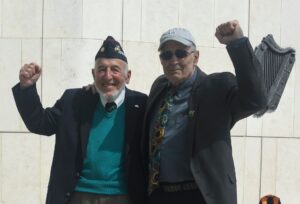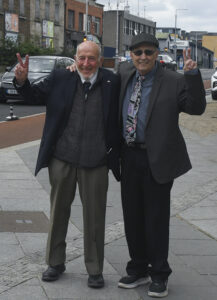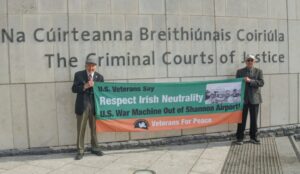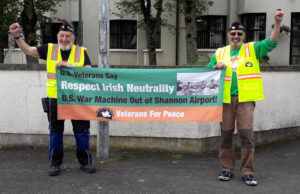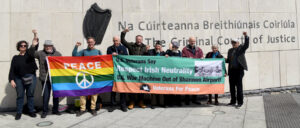from Stop These Wars
by Ellen Davidson
DUBLIN, May 3, 2022—A mixed verdict came down in the case of the Shannon Two today. They were found not guilty of the charges of criminal damage and trespass with intent to commit an offense, but they were convicted, by a vote of 10-2, of interfering with the operation, management, and safety of an airport. That charge was added two years after the original charges. They have to surrender their passports until they are sentenced.
Tarak Kauff, 80, and Ken Mayers, 85, went onto the airfield at Shannon Airport on March 17, 2019, to inspect any aircraft associated with the U.S. military that were at the airport. There were in fact three planes there at the time—a Marine Corps Cessna jet, and an Air Force Transport C40 aircraft, and one Omni Air International aircraft on contract to the U.S. military that they believed carried troops and weapons through the airport on their way to illegal wars in the Middle East, in violation of Irish neutrality and international law.
“The only thing we are guilty of,” said Kauff, “is not doing more in the cause of peace.”
The sentencing will take place tomorrow (May 4) at 11:30 am at the Circuit Court in Dublin.
DAY 3
Prosecution and Defense Rest in Trial of Shannon Two
DUBLIN, April 27, 2022—Both prosecution and defense wrapped up their cases today in the case of the Shannon Two, two U.S. military veterans who were arrested for entering the airfield at Shannon Airport on March 17, 2019.
Tarak Kauff, 80, and Ken Mayers, 85, went onto the airfield to inspect any aircraft associated with the U.S. military that were at the airport. There were in fact three planes there at the time—a Marine Corps Cessna jet, and an Air Force Transport C40 aircraft, and one Omni Air International aircraft on contract to the U.S. military that they believed carried troops and weapons through the airport on their way to illegal wars in the Middle East, in violation of Irish neutrality and international law.
The defendants are not contesting the fact that they created a hole in the airport perimeter fencing and entered the area without authorization. They say they did so for “lawful excuse,” in order to bring attention to the illegal transport of troops and weapons through the facility and to pressure authorities to inspect the planes, rather than accepting U.S. diplomatic assurances that munitions are not moving through the airport.
Nevertheless, much of the prosecution’s case consisted of witnesses from the police and airport security recounting the details of the men’s actions and the response from authorities. During the course of this testimony, it became clear that the chartered Omni flights were commonly known to be carrying troops and that no airport security or police officials had ever searched those planes or any U.S. military planes to determine if there were weapons or munitions on board.
The prosecution’s last two witnesses were Colm Moriarty and Noel Carroll, both from the Shannon Garda (police) Station. The two oversaw the interviews of Kauff and Mayers on the day of their arrest. The prosecutor read the transcripts of the interviews, which were confirmed by the two police officers.
The interviews show clearly the defendants’ intentions on entering the airfield. Both clearly explained that they were intending to inspect an Omni Air International flight that was on the ground at the time for troops or weapons.
Mayers said his authority was “the obligation of citizens to do what is right.” When asked about whether his actions put people in danger, he said, “I recognize that [by] unauthorized access to the airfield I created a small but finite element of danger, however, I know by allowing U.S. military and CIA aircraft to pass through Shannon, the Irish government is certainly putting many innocent people in serious danger.”
Kauff was equally clear on his priorities. When asked if he understood what “criminal damage” was, he responded, “I think so. It is something that the United States military have been doing for a long time in massive amounts.” He described his “lawful business in Shannon Airport” that day this way: “As a citizen of the United States and also as a veteran who has taken an oath with no expiry date to defend the Constitution against all enemies both foreign and domestic, and under international law, the Geneva Convention, I am legally mandated to oppose criminal activity of my own government, as were the Germans, who didn’t during World War II and the Nazi regime.”
Barrister Michael Hourigan opened the defense case by putting Mayers on the witness stand. Mayers described how his father had fought in World War II and the Korean War as a Marine, and so he “drank a lot of Marine Kool-Aid” growing up. He went through college on a military scholarship and joined the Marines when he graduated in 1958. Eight and a half years later he resigned his commission after seeing what was happening in Vietnam. He said the the Marines taught him that “the U.S. was not the force for peace in the world I had been led to believe.”
He eventually joined Veterans For Peace, and he read to the jury the organization’s statement of purpose, which speaks of working nonviolently to end war as an instrument of foreign policy, among other goals.
Mayers explained that, although he knew he was probably violating a statute with his actions, he felt it was necessary to prevent greater harm. He cited the war in Yemen, which is supported by U.S. equipment and logistics. “Even today, the people of Yemen are threatened with mass starvation,” he said. “Of all people, the Irish people should be aware of the importance of preventing this kind of mass starvation.”
He also noted that when planes from a belligerent country land in a neutral country, “that country has an obligation under international law to inspect [the plane].” He cited the 1907 Hague Convention on Neutrality requiring neutral countries to seize weapons from belligerent countries.
He described U.S. use of Shannon for military purposes as “a great disservice to the Irish people,” and pointed out that the vast majority of Irish people favor neutrality for their country. “If we can contribute to the enforcement of Irish neutrality,” he said, “that can save lives.”
Mayers described his action as “the best opportunity we had to make an impact.” He said, “I felt that the consequences of violating that statute were to me personally not as great as the consequences of not violating that statute.” Invoking the U.S. civil rights movement of the 1960s, he said, “Direct action by the citizenry ultimately is what produces change,” change that will not come about “without continued and forceful intervention by citizens.”
On cross examination, prosecuting barrister Tony McGillucuddy asked Mayers whether he had attempted other measures to get the planes at Shannon Airport inspected, such as petitioning public officials or asking police to do so. He cut Mayers off when he attempted to explain why he had not explored these avenues in this case, but in redirect, Mayers was allowed to explain that he was aware of many attempts by Irish activists to go through all the channels mentioned by the prosecutor, and that most of these efforts did not even receive a response from officials, much less any action.
The second and last defense witness was Tarak Kauff, who, in contrast to Mayers’ measured tone even in the face of intense and sometimes hostile questioning by the prosecutor, expressed passionately his frustration and anger with U.S. military use of Shannon.
Under questioning from defense barrister Carol Doherty, Kauff described joining the army at the age of 17 and getting out in 1962, just as U.S. involvement in the Vietnam War was escalating. He became an antiwar activist, citing his “responsibility as a human being and also as a veteran to object and oppose this warmaking.”
He first learned about U.S. military involvement at Shannon Airport in 2016, from veterans who were launching Veterans For Peace Ireland. “I believed it was my moral and human responsibility … to bring attention to this issue,” especially when children are dying, he stated. When asked about breaking the law with his actions, he said, “I’m talking about international law, war crimes, unlawful wars. It’s everyone’s responsibility.”
Kauff returned to Ireland in 2018 for a peace conference, and at that time engaged in a protest inside the Shannon terminal, using the same banner he and Mayers carried out on the airfield in 2019. Asked whether he thought that had been effective, he said, “Somewhat,” but that the planes were still coming through Shannon.
He compared them to the urgency of breaking into a burning building to rescue children inside: “What the U.S. was doing, with the compliance of the Irish government,” was like a burning building.
On cross-examination, McGillicuddy pointed out that Kauff had cut a hole in the airport fence, to which he responded: “Yes I did damage the fence, I was acting on my own moral beliefs,” he said. He also pointed out that “the U.S. government and the Irish government have been breaking the law. Irish people are sick and tired of their government kowtowing to the U.S. That is the issue here!”
“There’s a higher purpose here than the law which says you can’t trespass, that you can’t cut a fence,” Kauff said.
He spoke emotionally about how he personally knew veterans who had come through Shannon with their weapons, and also how veteran friends of his had committed suicide, unable to live with what they had done in the U.S. wars in Afghanistan and the Middle East. “That’s the real damage … Damaging a fence is nothing. Nobody died and I should expect that you should understand that as well.”
It is sometimes difficult to measure the effects of political activism, but it’s clear that Kauff and Mayers have lit a spark in the Irish movement for peace and neutrality with their actions at Shannon and the subsequent publicity when they were jailed for two weeks and then forced to stay in the country for another eight months before their passports were returned to them has lit a spark in the Irish peace movement.
When asked if he felt that his work for peace was effective, Mayers said that he had gotten “feedback from people who have been moved by what I’ve done.” He drew an analogy to the Grand Canyon, which he said was formed by countless drops of water. As a protester, he said, he felt “like one of those drops of water.”
The case, presided over by Patricia Ryan, continues with closing statements and jury instruction tomorrow.
April 28
A crowd of more than 20 supporters came out today to see closing arguments in the trial of the Shannon Two, but unfortunately, the case was put off until the next day, due something arising that Judge Patricia Ryan had to tend to. The case will reconvene Friday, April 29, at 10:00 am. Reports on the trial thus far can be found at stopthesewars.org.
DAY 2
Shannon Two Trial: Security Chief Doesn’t Know If Weapons Go Through His Airport
DUBLIN, April 26, 2022—The prosecution plowed methodically through its case in the second day of the trial of the Shannon Two. Since the defense has already stipulated to most of the facts that the testimony was meant to establish, the main new information the jury got from today’s witnesses was that defendants Ken Mayers and Tarak Kauff were model arrestees, pleasant, cooperative, and compliant, and that the airport’s chief security officer has no idea whether weapons are moving through airport he guards and admitted that he has never checked.
Mayers and Kauff were arrested March 17, 2019, at Shannon Airport for going onto the airfield to inspect any aircraft associated with the U.S. military that were at the airport. When they entered the airport there were two U.S. military aircraft at the airport—a Marine Corps Cessna jet, and an Air Force Transport C40 aircraft—and one Omni Air International aircraft on contract to the U.S. military that they believed carried troops and weapons through the airport on their way to illegal wars in the Middle East, in violation of Irish neutrality and international law. The U.S. and Irish governments, and the Irish Department of Foreign Affairs (which approved the refueling of the U.S. military aircraft at Shannon) maintain the fiction that there are no weapons being carried on the U.S. military aircraft, and that these aircraft are also not on military exercises and not on military operations. However even if this were true, the very presence of these aircraft passing through Shannon airport on their way to a war zone is in clear breach of international laws on neutrality.
Inexplicably, the Irish Department of Transport, which approves the refueling of civilian aircraft contracted to the U.S. military to transport troops through Shannon Airport, also approves the fact that most U.S. troops traveling on these aircraft are carrying automatic rifles with them through Shannon airport. This is also in clear breach of international laws on neutrality and is also arguably in breach of the Irish Department of Foreign Affairs prohibition on the transit of weapons of belligerent states through Irish territory.
The two men have pled not guilty to charges of criminal damage, trespass, and interfering with airport operations and safety.
The prosecution presented eight witnesses in the second day of the trial at the Dublin Circuit Court—three Garda (police) from the local Shannon station, two Shannon Airport Police, and the airport’s duty manager, its maintenance manager, and its chief security officer.
Most of the testimony concerned details such as when the intruders were first noticed, who was called, when and where they were taken, how many times they were read their rights, and how the hole in the airport perimeter fence through which they entered the airfield was repaired. There was also testimony about the temporary closing down of airport operations while airport personnel made sure there were no other unauthorized personnel on the airfield, and three outgoing flights and one incoming flight that were delayed by up to a half-hour.
The defense has already conceded that Kauff and Mayers had “been involved in the making of an opening in the perimeter fence,” and that they had indeed entered the “curtilage” (surrounding land) of the airport, and that the defendants had no issues with their arrest and subsequent treatment by the police, so much of this testimony was not needed to establish these matters of agreed-upon fact.
In cross-examination, the defense barristers, Michael Hourigan and Carol Doherty, working with solicitors David Johnston and Michael Finucane, focused more on the issues that had caused Mayers and Kauff to enter the airfield—the transport of troops and munitions through neutral Ireland on their way to illegal wars—and the fact that the two were clearly engaged in protest. The defense brought out the point that it was commonly known that flights by civilian airline Omni were chartered by the U.S. military and carried military personnel to and from the Middle East, where the United States was carrying out illegal wars and occupations.
Richard Moloney, Shannon Airport Police Fire Officer, said the Omni flight that Kauff and Mayers wanted to inspect “would be there for the purpose of transporting military personnel.” He compared Shannon Airport to a “big petrol station in the sky,” saying it was “strategically positioned in the world—perfect distance from America and perfect distance from the Middle East.” He said that the Omni troop flights used Shannon “for a fuel stopover or food stopover on their way to Eastern Europe and the Middle East.”
Shannon Garda Noel Carroll, who was the initial arresting officer on the scene, was at the airport at the time performing what he called “close protection of two American military aircraft” that were on Taxiway 11. He explained that this involved remaining “in close proximity” to the planes while they were on the taxiway and that three army personnel were also assigned to this duty. When asked whether he had ever been required to go aboard one of the U.S. military aircraft at Shannon to inspect it for weapons, he replied, “Never.”
The most surprising testimony came from John Francis, Chief Airport Security Officer at Shannon since 2003. In his position, he is responsible for aviation security, campus security, and security systems, and is the point of contact for Garda, armed forces, and other government agencies.
He noted when asked that he was aware of the prohibition on the transport of arms through the airport unless a specific exemption is granted, but said he was unaware of whether any arms were in fact transported through the airport or if any such exemption had ever been granted. He said that the Omni troop flights were “not scheduled,” and “they can show up any time,” and that he “wouldn’t be aware” if a plane carrying weapons was coming through the airport or whether any exemption had been granted to allow such transport.
The jury also heard testimony from five other prosecution witnesses: Airport Security Officer Noel McCarthy; Raymond Pyne, the Duty Airport Manager who made the decision to shut down operations for a half-hour; Mark Brady, the Airport Maintenance Manager who oversaw repairs to the perimeter fence, and Shannon Gardai Pat Keating and Brian Jackman, who both served as “Member in Charge,” responsible for assuring that arrestees’ rights are respected and that they are not mistreated.
Despite the prosecution’s focus on proving that Mayers and Kauff cut a hole in the perimeter fence and entered the airfield without authorization, facts the defendants readily concede, for the two U.S. military veterans, the central issue of the trial is continuing U.S. use of Shannon airport as a military facility, making Ireland complicit in its illegal invasions and occupations. Says Mayers: “The most important thing to come out of this trial would be a greater recognition on the part of both Irish elected representatives and the public of the importance of Irish neutrality and the great threat presented by the U.S. manipulation of governments around the world.”
Mayers also noted that the defense strategy would be that of “lawful excuse,” i.e. they had a legitimate reason for their acts. This tactic, known in the United States as a “necessity defense,” is rarely successful in protest cases in the United States, as judges frequently will not allow the defense to pursue that line of argument. He said, “If the jury finds us not guilty because of the Irish provisions in law for lawful excuse, it’s a powerful example that should also be followed by the United States.”
There was one other theme that emerged from the testimony today: Kauff and Mayers were universally described as polite and cooperative. Said Garda Keating, they were “probably the two best custodians I’ve ever had in 25 years.” Airport Police Fire Officer Moloney went further: It was “not my first rodeo with peace protesters,” he said, but these two were “the nicest and most courteous I have met in my 19 years at Shannon Airport.”
The trial, presided over by Judge Patricia Ryan, is due to continue at 11 am, Wednesday, April 27.
DAY 1
Trial Opens for Shannon Two in Dublin
DUBLIN, April 25, 2022—The trial of the Shannon Two got off to a faster than expected start today, moving through jury empaneling and the prosecution’s opening four witnesses.
The two, Ken Mayers and Tarak Kauff, were arrested March 17, 2019, at Shannon Airport for going onto the airfield to inspect U.S. military planes at the facility. They carried a banner that said, “U.S. Military Veterans Say: Respect Irish Neutrality; U.S. War Machine Out of Shannon.” Millions of U.S. troops have been moved through Shannon Airport since 2001 on their way to illegal wars in the Middle East, in violation of Irish neutrality and international law. The U.S. maintains that the troops are not going through the airport with their weapons, a fiction the Irish government accepts to avoid its lawful duty to inspect the planes. Kauff and Mayers were attempting to either inspect the planes or to get Irish authorities to do so, but they were instead arrested.
The charges against Mayers and Kauff—criminal damage, trespass, and interfering with airport operations and safety—were read and they pled not guilty to all three.
The men, who are U.S. military veterans and members of Veterans For Peace, had already spent two weeks in prison after being denied bailed immediately after their arrest. When they were finally granted bail, their passports were confiscated and they spent eight months in Ireland before their passports were returned and they could go home in early December.
During that time, the case was first moved up to the Circuit Court, assuring that they would get a jury trial, and then moved in venue from Ennis County, where the airport is located, to Dublin.
On the opening day of the trial, jury selection was interrupted for nearly half an hour when one juror asserted his right to take the oath in Gaelige (Ireland is officially a bilingual nation), and the court officer could not find the appropriate text. After much searching online and elsewhere, a scruffy book was produced that had the required text, and Judge Patricia Ryan struggled through the pronunciation to administer the oath.
After the jury was empaneled and the judge gave some instruction regarding their role, the prosecution opened their case. Barrister Tony McGillicuddy laid out the charges, and told jury members that they were the sole arbiter of fact in the case. Before McGillicuddy began calling witnesses, the two defense barristers, Carol Doherty for Kauff and Michael Hourigan for Mayers, both stipulated that the defense was not contesting that Kauff and Mayers had “been involved in the making of an opening in the perimeter fence,” and that they had indeed entered the “curtilage” (surrounding land) of the airport. The defense was hoping to move quickly through the uncontested areas of fact to what they view as the main point of the trial—putting the U.S. war machine, and Ireland’s complicity in it, on trial. Despite this concession, the prosecution proceeded with four witnesses whose evidence was intended to prove that Kauff and Mayers had cut a hole in the fence and entered airport property.
The first witness, a Garda (police) officer from Dublin, explained how he had traveled to Shannon and created maps of the airport, noting various relevant sites, such as where a pair of bolt cutters had been found, where the hole was in the fence, and the location of certain runways and taxiways. These maps were then used by the next two witnesses, Ennis County-based Garda Dennis Herlihy, who was called to the scene March 17 to investigate an “issue of criminal damage,” and Shannon Airport Police Fire Service Officer Trevor McMahon, who described his overnight shift on March 16, and how he patrolled the perimeter fence twice and found nothing abnormal. The final witness of the day was Shannon Airport Police Inspector James Watson, who was unable to appear in person, and whose statement was read into the record.
Kauff and Mayers have a different view of what the trial should be about. “The purpose is to, in our own way, put the government and the U.S. military on trial for killing people and animals, destroying the environment, and betraying the Irish people’s concept of their own neutrality,” said Kauff. “U.S. warmaking is literally destroying this planet, and I don’t want to be silent about it.”
Several peace activists attended the trial, including Ed Horgan, who works with Shannonwatch and founded Veterans For Peace Ireland and has himself been arrested three times for trying to inspect planes at Shannon. More supporters are expected when the case continues tomorrow at 11 am at the Circuit Criminal Court, Parkgate Street, Dublin 8.
When Kauff and Mayers returned to Ireland April 21, the immigration officer noted that “when you here the last time you caused some trouble, is there going to be any trouble this time?” The only trouble I’ve ever known these two to get into is “good trouble.” Let’s hope they continue that tradition.
